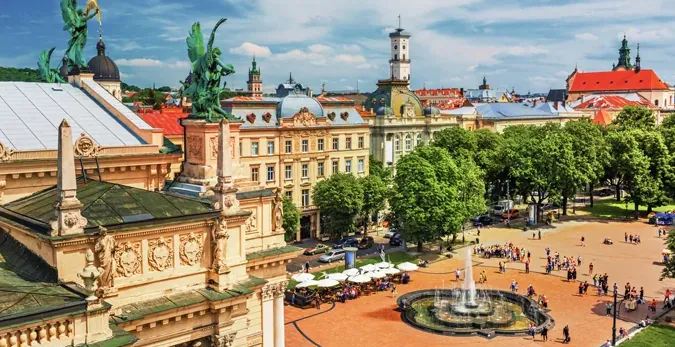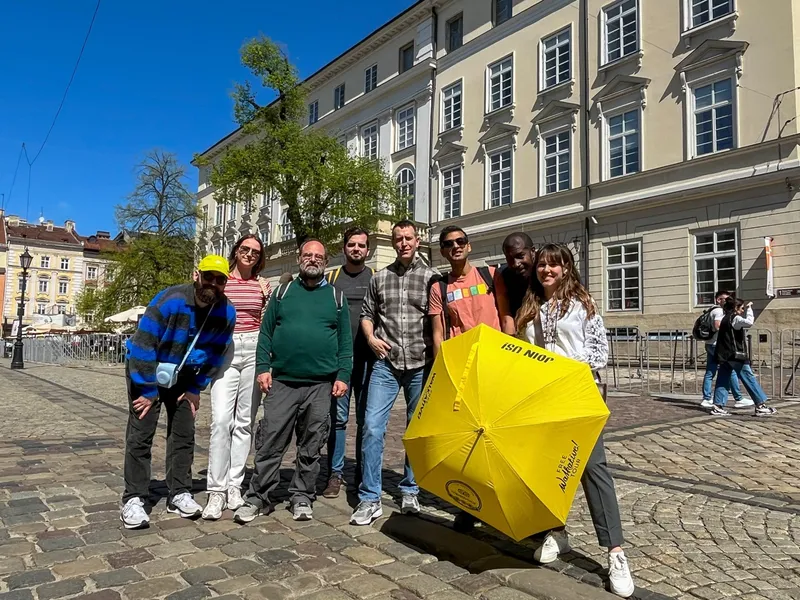Austrian Lviv Tour: Habsburg-Era Architecture and Palaces
A historical tour of Austro‑Hungarian Lviv focusing on Habsburg‑era architecture and urban growth. We cover the historic center and 19th‑century boulevards: the oldest trading passage, the main city avenue, the largest medieval church, Secession‑style housing, and grand palaces and theatres.

Basic Information
Total time
2h 30m
Language
English (check the calendar for availability)
Price
Our “Pay What You Wish” tours don’t have a fixed price — you decide how much the experience was worth. At the end of the tour, please make a fair contribution that reflects your satisfaction and appreciation for your guide’s work. Most guests give between €10 and €50 per person.
Meeting point
Neptun Statue next to the Town Hall, Information Center at Market Square Nearest public transport: Площа Ринок tram stop; Руська tram stop
Additional info
☂︎ This tour is organised by Walkative Lviv guides. Look for the guide with the yellow umbrella.
❗Our tours run in all weather conditions. High or low temperatures, rain, or snow are never a reason for us to cancel. We’re always here for you! The only reasons for cancellation are extreme weather conditions (such as heavy storms), a guide’s sudden illness, or if there are fewer than 5 registered participants. In such cases, we will always notify you using the contact information you provided when booking the tour.Booking rules
Booking is obligatory. Our “Pay What You Wish” tours are meant for individual travellers and small groups. Large groups (8 or more people) cannot join these tours, as they significantly affect the experience for others and the guide. For school trips, organised tours, or groups of friends, please arrange a Private Tour. For more information or to schedule a group visit, please contact us directly.
About the tour

19th century Lviv was the capital of the big imperial province and one of the biggest cities in Austria: this is where the province parliament worked with its official languages being Polish and Ukrainian, having a sizeable Jewish and Armenian minority and being a settlement for the university and many famous noble families with their glorious palaces. Austro-Hungarian period in Lviv (which is nearly 150 years) is often humorously called ‘Granny Austria times’. Lovely name to refer to a country, right? The Habsburg’s federal system granted many freedoms to the Ukrainians (called ‘Ruthenians’ at the time); first coffee houses and buildings with balconies appeared in Lviv during that period, city walls were dismantled and the city extended greatly. These and many more changes were brought by the Austrians. It was a period of cultural and economic growth and a bloom of architecture.La petit Paris or a brother to Krakow, that might remind you a bit of Prague, Vienna or Budapest – this is our noble Lviv.
Highlights
- 1
Granny Austria Times
Discover why locals fondly call the 150-year Austro-Hungarian period the era of ‘Granny Austria’.
- 2
Secession Architecture
Admire stunning buildings in the Vienna Secession style, a hallmark of Lviv's architectural bloom.
- 3
Noble Palaces & Casinos
See the lavish residences of noble families and glamorous casinos that defined 19th-century high society.
- 4
Old Trading Passage
Explore the city’s oldest covered shopping arcade, a hub of commerce with original old advertisements.
- 5
The Grand Avenue
Stroll along the main city promenade, the heart of Lviv's social and cultural life.
- 6
Austro-Hungarian Housing
Observe diverse housing styles from the era, reflecting the city’s social and economic growth.
- 7
Lviv Coffee Culture
Learn about the first coffee houses that appeared in the city during the Austrian period.
Map
Neptun Statue next to the Town Hall, Information Center at Market Square Nearest public transport: Площа Ринок tram stop; Руська tram stop




